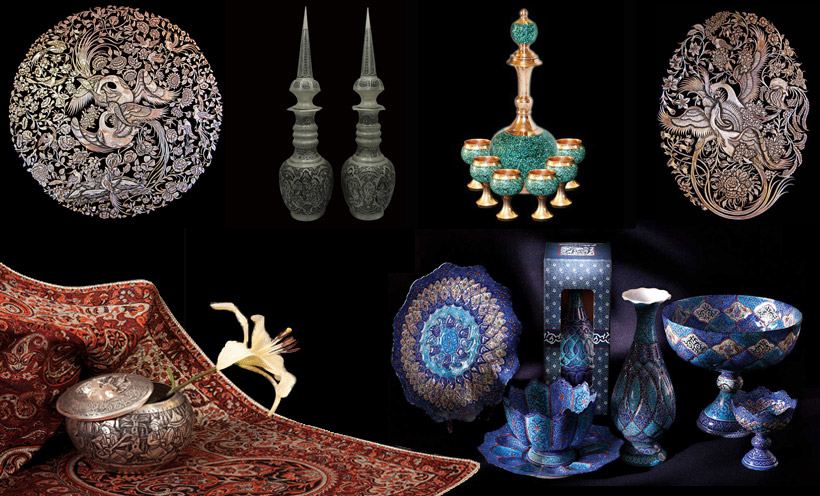
Handmade Jewelry and Metalwork in Iran: Craftsmanship Through the Ages
Introduction: A Timeless Expression of Iranian Art
Handmade jewelry and metalwork in Iran represent some of the oldest and most refined artistic traditions in the world. From ancient gold ornaments of the Achaemenid Empire to the intricate silver filigree of modern artisans, Iranian metalwork embodies a unique blend of cultural heritage, technical expertise, and artistic innovation. Today, these crafts remain an integral part of Iran’s identity and continue to captivate global markets with their authenticity and beauty. This article explores the historical roots, craftsmanship techniques, economic significance, and global appeal of Iran’s handmade jewelry and metalwork.
Historical Background: Thousands of Years of Mastery
Iran’s metalwork traditions date back more than 5,000 years. Archaeological discoveries from regions such as Lorestan, Susa, Marlik, and Persepolis reveal advanced metal-smithing techniques long before many other civilizations. Ancient Iranian craftsmen produced:
-
Gold and silver jewelry
-
Bronze ceremonial vessels
-
Ornamental weapons
-
Religious and royal artifacts
During the Achaemenid and Sassanian periods, jewelry making evolved into a highly sophisticated art form. Kings, nobles, and warriors wore finely crafted pieces adorned with turquoise, lapis lazuli, and gemstones sourced along the Silk Road. Later, Islamic influences introduced calligraphy, arabesque motifs, and geometric patterns, enhancing the aesthetic diversity of Iranian metalwork.
Today, these traditions continue to inspire modern artisans, ensuring that the legacy of Iranian craftsmanship remains alive and thriving.
Techniques and Craftsmanship: The Art Behind the Beauty
Iranian handmade jewelry and metalwork stand out for their meticulous techniques, each requiring years of practice and artistic intuition. Some of the most notable methods include:
1. Filigree (Malileh-kari)
A delicate process involving twisting thin silver or gold wires into intricate lace-like patterns. The city of Zanjan is a renowned center for this craft.
2. Engraving (Ghalam-zani)
Artisans carve detailed motifs—such as floral designs, hunting scenes, or geometric patterns—onto copper, silver, or brass surfaces. Isfahan is famous for this art form.
3. Turquoise Inlay (Firoozeh-koobi)
Small turquoise stones are meticulously set into metal surfaces to create vibrant blue textures. This technique thrives in Mashhad and Nishapur, home to world-class turquoise mines.
4. Hammering and Repoussé
Metal sheets are shaped and decorated by hammering from both the front and back to produce 3D relief designs.
5. Traditional Jewelry Making
Artisans combine:
-
Gem cutting
-
Stone setting
-
Casting
-
Hand polishing
to create necklaces, rings, bracelets, and earrings inspired by Persian motifs.
These techniques demonstrate not only technical skill but also a deep cultural connection embedded in every piece.
Regional Styles Across Iran
Iran’s diverse geography and cultures have led to distinct jewelry and metalwork styles:
-
Isfahan – famous for silver engraving, blue inlay work, and fine metal ornaments.
-
Zanjan – celebrated for filigree jewelry and delicate silver pieces.
-
Kerman – known for decorative metal armor, daggers, and traditional accessories.
-
Tabriz – a center for sophisticated gold jewelry and stone cutting.
-
Mashhad – renowned for turquoise-inlaid products and religious metalwork.
-
Lorestan – home to ancient bronze traditions and tribal jewelry.
Each region contributes a unique artistic identity, enriching the overall landscape of Iranian metal craftsmanship.
Economic Significance of Metalwork and Handmade Jewelry
Iran’s jewelry and metalwork sectors play a significant role in supporting local economies—particularly rural and artisan communities. The industry benefits from:
-
High-value exports, especially turquoise-inlaid items and silver jewelry
-
Strong domestic demand, driven by cultural traditions and gifting
-
Employment opportunities for skilled artisans and apprentices
-
Growing global markets seeking authentic handmade crafts
Unlike mass-produced items, Iranian handmade jewelry offers uniqueness and cultural depth, allowing artisans to command premium prices in luxury and boutique markets.
Export Markets and Global Appeal
Handmade Iranian jewelry has built an international reputation for quality and authenticity. Major export destinations include:
-
Europe – Germany, France, Italy, and the UK
-
Gulf countries – UAE, Qatar, Kuwait
-
East Asia – China, Japan, South Korea
-
North America – depending on market access
International buyers value Iranian metalwork for its:
-
Natural turquoise and semi-precious stones
-
High silver purity standards
-
Artistic heritage
-
Eco-friendly, handmade production
Online platforms and global craft markets have dramatically increased international visibility, helping Iranian artisans reach new audiences.
Why Iranian Handmade Jewelry Stands Out
1. Authentic Cultural Designs
Persian motifs—like paisleys, pomegranates, mythical creatures, and Islamic calligraphy—give each piece a unique identity.
2. Premium Quality Materials
Iran is home to some of the world’s best turquoise and semi-precious stones, adding natural value to handcrafted pieces.
3. Durability and Craft Precision
Handcrafted metals, when combined with traditional techniques, create long-lasting jewelry admired for its strength and detail.
4. Ethical and Sustainable Craftsmanship
Most pieces are produced in small workshops without industrial chemicals, making them eco-friendly and artisan-centered.
5. Artistic and Investment Value
Collectors value handmade Iranian jewelry not only for beauty but also for craftsmanship with long-term cultural significance.
Challenges and Future Opportunities
While the industry remains strong, several challenges persist:
-
Global competition from cheaper mass-produced jewelry
-
Limited international branding and marketing
-
Difficulty accessing certain export markets
-
Shortage of young artisans entering traditional crafts
However, opportunities are growing:
-
Rising global demand for handmade, sustainable products
-
E-commerce platforms that support direct-to-consumer sales
-
Luxury market interest in rare and artisanal goods
-
Tourism-based craft revitalization
With strategic branding, preservation efforts, and international partnerships, Iran’s handmade jewelry industry can continue expanding globally.
Conclusion: A Craft That Connects Past and Present
Handmade jewelry and metalwork in Iran represent more than artistic traditions—they are living cultural expressions that have endured for millennia. From ancient royal ornaments to modern silver filigree, Iranian craftsmen continue to create pieces that reflect beauty, history, and emotional depth. As global consumers increasingly value authenticity and artisanal craftsmanship, Iranian jewelry and metalwork are well-positioned to strengthen their legacy on the world stage.

